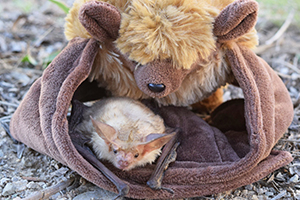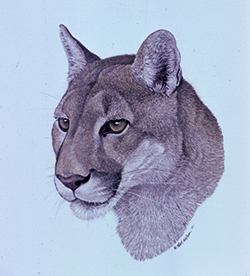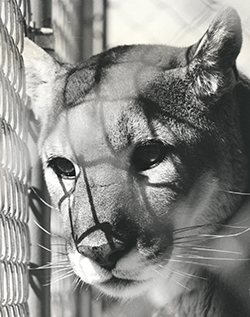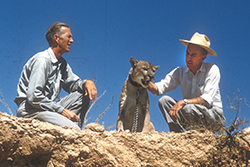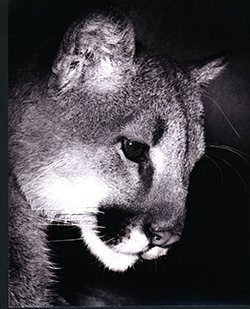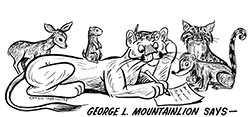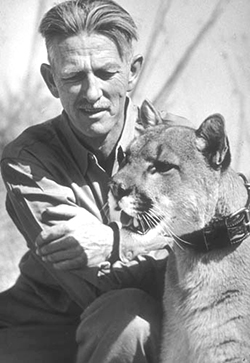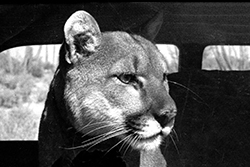
And then there was George
It was February 22, 1953, and the Desert Museum was a mere six months old when Bill Carr invited my husband Merv, and me to accompany him to the Tucson Airport to pick up a distinguished arrival—the Museum’s new male mountain lion. In the terminal, a small crowd of people stood around a traveling cage, exclaiming over the ferocious, growling mountain lion they could barely see, but clearly hear through the heavily screened cage door. Actually what they were hearing was the purring and yapping of a friendly and excited young lion.
With the lion loaded in back of the station wagon we headed for the Museum and during the drive admired the lion’s obviously friendly nature and vocalizations. All the way we talked to him and he talked to us. By the time we arrived at the Museum we were convinced he was a friendly cat, not a ferocious lion. Bill asked Merv and me if we’d like to go in the lion’s enclosure as the lion was released from the traveling cage. We were delighted to accept. There we stood. Three people in a lion cage.
The end gate of the cage was opened. The lion was eager. As we watched him exit the cage, it seemed that he grew longer and longer, larger and larger. He appeared to have been too big to fit into the traveling cage. What emerged was a slim, rangy, long-legged, big-footed, adolescent, near-adult-sized lion. As he grew before our eyes, Bill, somewhat panicked, indicated we all needed to move “quietly and calmly” toward the nearest exit (which was the only one). Looking back on our controlled but rapid retreat that day, I’m sure if we’d looked at the lion, instead of at the door, we’d have seen our new friend with a puzzled expression on his lion face. We soon learned that the lion had grown up among people and enjoyed their attention. That day I think he must have wondered why we didn’t stay to get better acquainted.
It was George Washington’s birthday when the lion arrived. He became George (for the holiday). Bill added the initial L. for Leo the Lion, and combined two words, mountain and lion, for a surname. Thus George L. Mountainlion came to the Desert Museum. George became a weekly columnist (with a little help) for the Arizona Daily Star and the Museum’s icon for all time. Over the Museum’s 65 year history, several other Georges followed the first. We have loved them all.
— Peggy Larson, November, 2016
With the Desert Museum’s 65th anniversary ‘just around the corner’, it seems appropriate to check in with George for his perspective.
Interview with a Lion
George L. Mountainlion and Peggy Larson
“George, so many fine things have happened at the Desert Museum as a result of your efforts. What are the accomplishments of which you’re most proud?”
I was interviewing George L. Mountainlion for our Archive/Interview/Vignette Program. For 64 years George has been the Museum’s icon and I realized his interview should have been the first conducted in the hundred that have been completed. I apologized and told George his was the very first we have conducted of any of the Museum’s animal residents. He was polite and said he was pleased to be included.
“I’ve been the face of the Museum for years and I’m really purr-r-r-oud of that,” he told me. “Look at the Museum’s letterhead, you’ll see my face on every letter that goes out and it’s been on loads of invitations, brochures, and— you name it!”
“Obviously, I’ve lived the Museum’s history since arriving here when the Museum was barely six months old. I was a big-pawed adolescent then, and Bill Carr arranged for me to be the Museum‘s Very Special Resident!” (George has always had a very positive self-image. P. L.)
“As you well know, I’m a Literate Lion and a Catamount Columnist. For many years I wrote a weekly column about Museum happenings for the Arizona Daily Star. And certainly I’ve been instrumental in gaining publicity for the Museum for more than half a century.”
“Especially I’m proud of the fact I’ve been able to advise the Museum Directors — all eleven of them — on Museum matters. And I’m a liaison between staff and our resident animals, helping insure their well-being. For example, it was my idea to build comfortable “geriatric” quarters for our older animals entering retirement.” (George explained, off the record, that he has absolutely no intention of retiring. P.L.)
I asked George a key question, “What would you like the Museum to be on its hundredth anniversary?” That caused some puma-pondering before he replied.
“Well, you know, the Museum started with a terrific mission, but limited exhibits. We displayed reptiles and small mammals in one room, outside “cages” housed larger mammals, and a couple of paths wandered among desert plants. Then, under my watch (told you! P.L.) the Museum has been transformed with naturalistic habitat enclosures; major docent and volunteer programs; extensive education, science, and conservation programs; a renowned Congdon Earth Sciences Center; a 300-seat theatre; food services; public programs such as Raptor Free Flight; and a highly successful Art Institute.” (Just know, we couldn’t have done it without you, George! P.L.)
Our favorite lion concluded, “The Desert Museum has been called ‘a miracle in the desert’. I’m proud to have had a hand — oops, four paws — in its success. At its hundredth I want it to be a miracle in that age for conservation of, and appreciation for our Sonoran Desert — and especially for mountain lions!”
Photos courtesy of ASDM Archives.



